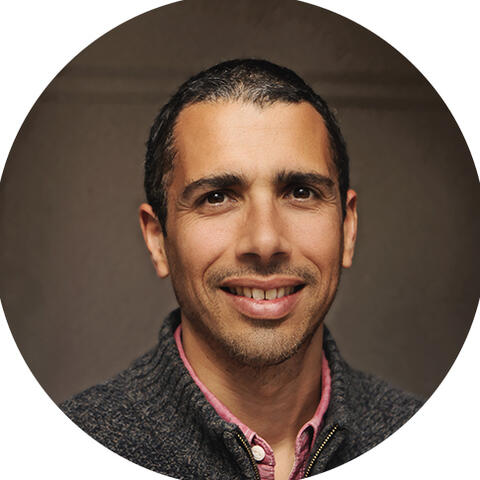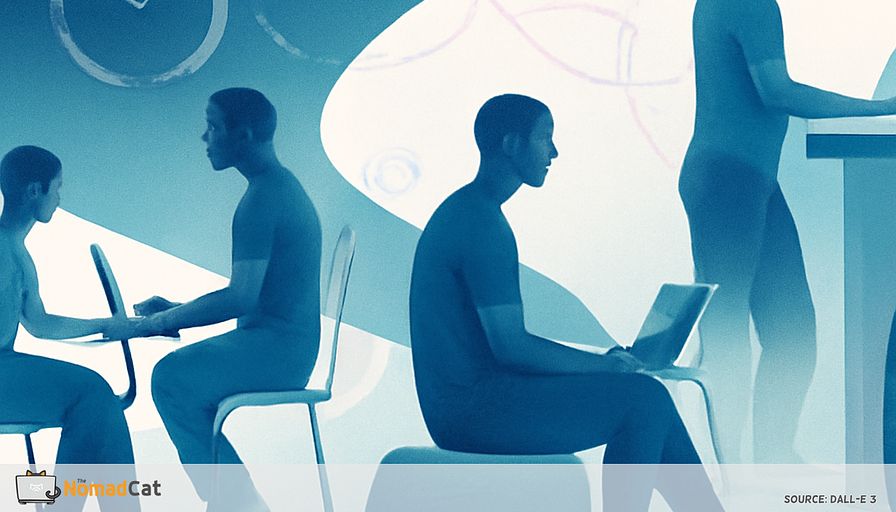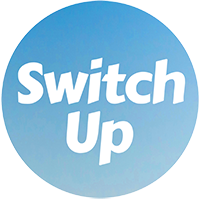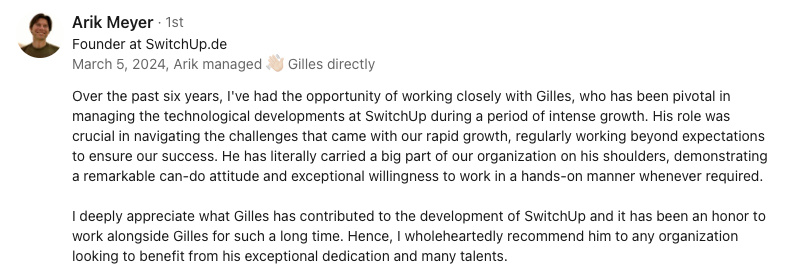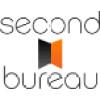Abstract:
The article challenges the traditional belief that a perfectly arranged desk and posture guarantee comfort for tech professionals, emphasizing instead that regular movement is far more important for sustained well-being and focus—especially for those working in minimalist, mobile, or makeshift spaces. Drawing on both research and real-world anecdotes from independent workers, it highlights that holding any position, even an ergonomic one, leads to discomfort, and advocates for the principle that “the best posture is the next posture.” The piece offers practical, low-cost strategies such as using cushions, books, and household objects to create adaptable workspaces, and suggests building movement into the day through fidgeting, micro-movements, and analog reminders like sticky notes or timers. It further describes creative adaptations for small apartments, co-working spaces, and even kitchen tables, showing how simple cues and habit-stacking—like placing items out of reach or linking posture shifts to workflow milestones—can make healthy movement automatic. The article’s tone is approachable and lightly humorous, with examples like stretching alongside a curious pet, and it underscores that minimalist, flexible routines are not only effective for reducing aches and boosting focus but also align with the creative, problem-solving mindset of independent tech workers. Ultimately, it concludes that comfort and productivity are best achieved by staying adaptable, using what’s at hand, and making frequent, small changes rather than striving for a rigidly perfect setup.
Forget the old advice that says all you need for comfort is a perfect desk setup. I’ve learned the hard way—whether in a cramped Lisbon apartment, a noisy Berlin co-working space, or even a Beijing hostel—that even with everything set just right, sitting still for hours quickly turns any space into a challenge. For me, staying comfortable and feeling sharp relies much more on movement than on posture alone.
So, here’s what I’ve figured out after years of working independently and moving between countries: perfect posture isn’t enough, especially if you’re like me—working from simple or mobile setups. In this article, I’ll share:
- Why moving often beats holding one position, even if it’s ergonomic
- How switching between sitting, standing, or just fidgeting can help you stay comfortable and focused
- Simple, low-cost ideas for using everyday items to make your workspace more flexible
- Easy habits and physical reminders to build movement into your day automatically
- Real strategies (and a few stories) from my own tech journey, keeping setups simple and adaptable
Whether you’re squeezed into a tiny flat, hopping between co-working spots, or just at the kitchen table, these tips show how small changes can make a big difference. Expect clear advice, a bit of humor, and a friendly approach—no pricey gear or complex routines needed. Ready for a fresh take on your workspace? Let’s get moving.
The myth of perfect posture—and why movement matters more
Static posture limits
You can set up your workspace perfectly: shoulders back, feet flat, screen at the right height. I’ve done it, following every ergonomic checklist. At first, it feels like you’ve solved the problem. But a few hours in, even the most perfect setup loses its magic. Research shows that staying in any position—no matter how ergonomic—can cause discomfort, tiredness, and even injury. Being still too long reduces blood flow, puts muscles under stress, and saps energy. That’s why experts have started to question the idea of a single best posture.
The best posture is the next one
Instead, many in ergonomics now say, “the best posture is the next posture.” This isn’t just a catchy phrase. It means that shifting around—even a little—matters much more than picking and holding the best position. A simple shift, like leaning back or standing for a few minutes, makes a real difference in how you feel and perform throughout the day.
Movement makes the real difference
People who change up their sitting or standing method—choosing between a regular chair, stool, or even sitting on the floor—tend to have less pain and better focus than those who cling to a perfect arrangement. True comfort and productivity rely on weaving movement into your day, not chasing a mythical ideal. For many tech professionals with simple or changing setups, this flexibility is key for feeling good over the long run.
Small shifts, big impact
Dynamic sitting means using chairs or setups that let you move naturally—maybe rocking a bit, readjusting your legs, or changing how you sit. These little changes keep muscles active and prevent aches and pains. Even sitting on an old cushion or using a seat that wobbles a bit can help you move more. Standing mixed in with sitting brings its own benefits.
You don’t need fancy gear to work standing up. Propping your laptop on stacks of books or using a kitchen counter as a desk does the trick. I remember in Lisbon, my kitchen counter was my standing desk for months. Research backs this up: standing for just 8 minutes every half hour can reduce lower back pain by up to 30%. That’s a big deal, especially if you’re in a small or makeshift workspace.
Regularly swapping between sitting and standing reduces daily aches and helps you feel better over the long haul. For solo tech workers who lack ergonomic office setups, choosing movement is one of the best ways to stay comfortable and focused.
Fidgeting and micro-movements
Fidgeting—like shifting around or tapping your feet—usually gets a bad rap in traditional offices. But studies show these small moves help blood keep flowing, stave off muscle tiredness, and prevent you from stiffening up. Instead of being disturbing, these motions are your body’s natural way of handling long work sessions.
Breaking up sitting time with lots of little moves brings other health perks, too. These habits are linked to a lower risk of heart and muscle problems—even in folks who exercise regularly outside of work. For anyone working in a simple or portable setup, tuning into your body’s cues for movement is a practical, no-tech way to beat tension and stay productive. That urge to fidget? It’s a tool that works perfectly for flexible, independent work.
Minimalist tactics for dynamic sitting and standing
Creative workspace hacks
You don’t need fancy chairs to keep moving. With a bit of creativity, home objects can help you adjust and shift around. Here are some things I’ve tried:
- Cushions or pillows: add lower back support or give you a little height boost.
- Footstools, yoga blocks, or backpacks: work as footrests so you can change leg positions.
- Stacks of books: raise your screen or seat to eye level, or make a temporary booster.
- Blankets or mats: make sitting on the floor comfier so you naturally change positions more often.
A little improvising turns almost any space into an adjustable workspace. The comfort you need might be just a pillow or book away.
Mixing up how you sit—hopping between stools, crossing your legs in a chair, or setting up on the floor—brings healthy variety. If you’re in a small apartment or moving between spots, it saves space and helps your body move naturally. Using a stool can open your hips and get your core working, while sitting on the floor usually leads to moving around more often. Moving between these setups really helps cut down on stiffness from holding one pose all day.
Standing options can be simple, too. Kitchen counters, tall tables, or boxes make fine standing desks. Just check your setup with a quick list:
- Elbows bent about 90 degrees while typing
- Wrists straight, not bent up or down
- Screen at eye level to avoid neck strain
A kitchen island might be perfect for typing, and a stack of books or a bin can do in a pinch. These adjustments help keep you comfy and protect against common issues from too much standing.
Footrests make a surprising difference whether sitting or standing. You can use a box, books, or even a bag for this job. Swapping footrests as you shift helps your legs move and lowers pressure. This comes in handy in tight spots, since there’s no need for special gadgets. Often, the trick to feeling better is just making small swaps with what’s nearby.
Micro-adjustments and movement habits
The secret weapon for comfort is frequent small movement. Fancy tools aren’t needed. Here are a few simple ways to keep your body going:
- Rock slightly in your chair or shift from side to side.
- Change how your legs rest: flat, crossed, or tucked.
- Roll your shoulders or stretch overhead.
- Wiggle toes or tap feet.
Even if these changes seem tiny, they add up. Short standing breaks also help, and it’s easier than you think to time them with natural pauses in your routine.
Quick standing sprints—just a few minutes upright after sending emails or wrapping up a video meeting—are easier to keep up with than longer standing stretches. These fit right in with your day and help you stay energized and comfy.
Simple desk exercises like neck rolls, wrist stretches, or gentle seated marches can be done without leaving your chair. Besides helping you loosen up, they add a little humor—just watch for the odd look from your cat or colleague. No need for a gym, just the willingness to move occasionally.
When standing, changing your foot position is an easy way to ease fatigue: alternate both feet flat, one foot forward, or use a box or bag as a prop. A nearby object like a water bottle can remind you to shift now and then. Making this automatic helps you feel less tired as the hours go by.
Analog cues—note cards, timers, or placing your phone away—work well as reminders to keep moving. These prompts are simple, but help build real movement habits into your work, no matter your space or setup.
Analog cues and workflow habits for easy posture shifts
Visual prompts for movement
Sticky notes may not be fancy, but they remind you to move. Put a bright note on your screen or desk and it’s hard to miss the gentle nudge to stand, stretch, or shift around. Unlike digital alerts, these stay visible without cluttering your phone or computer. Even a favorite mug or pen in a certain spot can act as a prompt. Research backs up visual cues for breaking up long sitting spells—they're a reliable trick to avoid being stuck for too long.
Everyday objects as movement nudges
Arranging your workspace pushes you to move even if you don’t mean to. By placing your water bottle or cup just out of reach, you’ll need to get up for a refill. A notebook or phone on a nearby shelf makes you stretch or take a step every so often. These little shifts turn normal tasks into natural chances to move during the day. Making items a bit less handy nudges you to change position throughout your routine.
Rearranging your space
Combining cues with habits—sometimes called habit-stacking—goes further. Put things you use regularly, like chargers or books, so you need to stand or walk to get them. For instance, set your printer on another table, or put your charging cable across the room. This setup means you naturally get up a few times a day. Rather than thinking about moving, it just happens, helping posture changes become a normal part of your workflow.
Linking movement to workflow
Pairing position changes with transitions in your work is practical. For example, stand up after finishing a call, stretch after a round of emails, or switch seating once some code updates. These tasks become triggers, so moving happens naturally without overthinking. Little rules—like always shifting after a meeting—give just enough structure to keep things consistent, even when busy.
The 20-8-2 rule
A simple approach: for every 30 minutes, try sitting for 20, standing for 8, and moving for 2. This 20-8-2 method is easy to remember and not too strict. After a focused spell, stand and stretch quickly to recharge. This balance supports movement while fitting into a normal tech work routine.
Analog timers for reminders
I’ll be honest: I much prefer analog timers over digital reminders. Analog timers are more effective than digital reminders for building movement habits. A classic kitchen timer, an hourglass, or a wind-up clock nudges you gently to move. Setting a timer for 30 minutes is enough to remind you to shift or take a quick walk. Some people enjoy the ticking sound, while others prefer the look of sand running out. These tools fit minimalist work styles and even bring some quirky charm to your space. Plus, they don’t clutter your phone with yet another notification.
Body awareness practices
Checking in with your body makes tension easier to spot. Every hour, pause and scan yourself for sore spots in your neck, shoulders, back, or legs. Early detection lets you adjust or stretch before pain sets in, helping you stay comfortable all day.
Quick posture checks
A quick alignment check can help in changing work setups. Line up your head, shoulders, and hips, and watch for slouching or awkward twists. A sticky note nearby reminds you to do this now and then. This habit goes a long way towards avoiding slow-building aches.
Frequent, brief breaks
Standing up or stretching every 30 to 60 minutes is the core of staying comfortable and healthy. Even just walking to the window or stretching between tasks adds up. One way to keep track: match breaks with work transitions or jot a tally mark on paper. Many people have found that these simple strategies work well, especially for those who enjoy a blend of autonomy and health in minimalist workspaces.
Real-world tactics for dynamic posture in minimalist workspaces
Everyday strategies from independent tech professionals
Reports from developers and writers show the value of mobility and simplicity. Light chairs or stools are easy to move whenever it’s time for a change. Devices like tablets or slim laptops make switching spots effortless—desk to couch to counter in a snap. Portable standing desk risers are popular too, making it easy to stand without bulky gear. The lesson: simple, mobile setups make frequent posture changes easy. This adaptability works well in all kinds of spaces, from small apartments to co-working hubs or when out traveling.
Creative adaptations for small and mobile spaces
I remember working in Berlin, where my “desk” was a kitchen counter by day and a dinner table by night. In Beijing, I used a pile of books and a shoebox to raise my laptop to eye level, and sometimes just sat on the floor with a cushion. That’s why portable standing desk converters are favored—you can stand at any flat surface. Sitting on a kitchen stool encourages active sitting. A cushion on the floor with a low table lets you change it up, no special furniture required. The main idea: use whatever you have to keep yourself moving and comfortable wherever you are.
Adaptability over perfection
Aiming for the one perfect setup doesn’t work for everyone. Instead, many professionals focus on matching their environment to their changing needs. A quick move from chair to floor or desk to kitchen counter can refresh your body and mind, breaking up routine. Comfort comes from easy changes, not sticking to a strict routine. This flexibility supports focus and well-being, especially when you’re working in less predictable or tighter spaces.
By the way, my background in physics makes me see posture as a problem of forces and energy. If you keep your body in one position, you’re fighting gravity the whole time—no wonder you get tired! Small shifts spread the load, like moving a lever to a new spot. It’s not just theory; it’s what keeps me sane during long coding sessions.
Micro-breaks and mindful transitions for sustained comfort
Posture shifts as mental resets
Switching up your posture for a minute or two can wake up your body and mind. Micro-breaks reset your focus, give your eyes a break, and can add a bit of fun—like stretching only to find your pet joins in. Tying these moves to everyday work tasks helps make them automatic and sustainable, bringing relief and a little clarity.
Movement tied to workflow
Movement linked to workflow—instead of relying on reminders—makes healthy habits stick. Stand after emails, stretch before meetings, or switch seating once a task ends. These natural moments serve as hidden nudges, breaking up stillness, and helping these habits last. For anyone working with minimalist values, it’s a way to improve comfort without any extra steps.
Minimalist philosophy—using what you have
This approach fits perfectly with minimalist ideas: rather than buying new tools, make small changes using the routines and items you already have. Connecting posture changes to regular tasks builds a movement-friendly rhythm. Over time, this adds up to better comfort, focus, and well-being. The evidence says that small, low-effort changes—like using a kitchen stool—are usually the ones that stick for both health and productivity.
Long-term benefits of dynamic posture and minimalist strategies
Less discomfort, more focus
Over time, these habits show real benefits. People who alternate sitting and standing and make lots of micro-movements enjoy less back and neck pain, even months later. This approach lasts longer than ergonomic setups that only offer quick fixes. Movement built into your day helps you stay comfortable and avoid growing tension. Plus, working in different postures supports mental focus. Studies back up that mixing up movement can sharpen alertness; people often say they feel more engaged when they keep moving. Simple, adaptable routines are easier to keep up with, especially for tech workers with unpredictable days. By mixing up your posture, you help both your body and mind stay fresh and comfortable.
I’ll admit, when I moved from Berlin to Lisbon, I struggled with back pain and brain fog. But after I started using micro-breaks and switching between sitting and standing, I felt real relief—sometimes it was like a breath of fresh air. There’s a kind of renewed energy that comes from not being stuck in one spot, and it’s honestly made my workdays much more enjoyable.
Minimalism and adaptability—why less is more
Minimalist ideas—like using nearby objects, analog reminders, and body awareness—work well in small spaces, mobile setups, and changing daily routines. There’s no need to commit to one right way forever. For example, a cushion can boost your seat on Monday and support your back on Tuesday. A kitchen counter goes from breakfast spot to standing desk in seconds. This kind of creativity saves both money and space.
Flexible habits make movement routines last for the long run. People often find that easy, switchable setups are the ones that stick. Dynamic posture isn’t about expensive gear—it’s about using what’s at hand, staying comfortable, and creating the environment that fits your needs right now.
Honestly, I see a lot of overlap with my hobbies. When I’m doing carpentry or gardening, I’m always shifting, bending, or reaching. Those movements keep me loose and focused. It’s the same with tech work—if you keep moving, you stay sharper and less stiff.
Adding movement and flexibility isn’t just about health. It also encourages creative, problem-solving thinking, which fits well with independent tech work. Shifting positions and adapting setups helps you stay comfortable and keep your head clear, even in long or cramped days. The most effective strategy is the one that slides easily into everyday life—letting you stay active, focused, and ready for what comes next.
It’s movement—not just the right chair or desk—that brings real comfort and focus, especially in small or shifting spaces. Changing up positions, putting home items to use, and adding simple reminders help refresh both body and mind. Even tiny actions like fidgeting or brief standing can mean fewer aches and more energy. Minimalist ideas add flexibility, so you can adapt without spending extra. Instead of chasing one right way to sit, stay open to what feels best in each moment. Over time, these habits support both well-being and clearer thinking—no matter where you work. The best changes are often the smallest, found right within reach.
